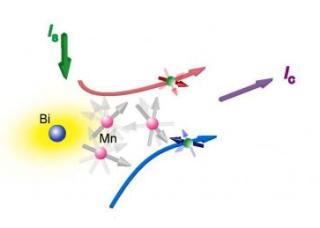Dec 22 2015
Electrons have two degrees of freedom, or attributes: charge and spin. With the development of microfabrication technology in recent years, through the active combination of these two attributes, it has become possible to create devices that are head and shoulders above electronics of the past.
This field of study has been called "spintronics," and some notable achievements in the field include the magnetic head of hard disk drives and magnetic random access memory (MRAM). The 2007 Nobel Prize in Physics was awarded for the discovery of giant magnetoresistance effect, which is the source of spintronics.
 A pure spin current 'Is' is converted into a charge current 'Ic' at the Bi impurity site which has no magnetic moments but converts 'Is' into 'Ic' via its strong spin-orbit interaction. Red and blue arrows with green spheres are spins of conduction electrons (|e|) and the shadows indicate that the conduction electron spins are randomized by the localized magnetic moments at the Mn sites. The curved arrows show the motions of spin-up and spin-down electrons. Credit: Osaka University
A pure spin current 'Is' is converted into a charge current 'Ic' at the Bi impurity site which has no magnetic moments but converts 'Is' into 'Ic' via its strong spin-orbit interaction. Red and blue arrows with green spheres are spins of conduction electrons (|e|) and the shadows indicate that the conduction electron spins are randomized by the localized magnetic moments at the Mn sites. The curved arrows show the motions of spin-up and spin-down electrons. Credit: Osaka University
Understanding spin-dependent transport properties is at the heart of spintronics. A pure spin current, flow of spin angular momentum without charge current, is one of the important physical quantities in the field of spintronics, because it could play an essential role in low energy consumption electronics of the next generation. On the other hand, the pure spin current should also probe some spin properties in a sensitive way since there is no net charge current, but it has not been utilized for such fundamental research so far.
A group of researchers from Osaka University, The University of Tokyo, Centre national de la recherche scientifique, Université Paris-Sud, Japan Atomic Energy Agency, and RIKEN reported that magnetic fluctuations can be detected with pure spin current. To investigate such magnetic fluctuations, spin glass was chosen. The spin glass is a typical frustrated system where a small amount of impurities with magnetic moments is randomly distributed in a nonmagnetic host metal. At high temperatures, the magnetic moments are fluctuating with a very high speed. As the temperature approaches the spin glass temperature Tg, the fluctuations become slower and then the magnetic moments are frozen at Tg. This has been well studied in many spin glass systems with magnetization measurements.
In this research, the pure spin current was injected into a spin glass system (CuMnBi alloy). An anomaly was observed far above Tg. This result indicates that pure spin current can detect fluctuating magnetic moments in a much more sensitive way than conventional magnetization measurements. In the near future, magnetic sensors with pure spin current would be developed and replace the superconducting quantum interference device (SQUID).